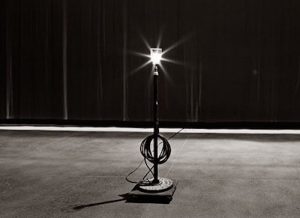
We rolled the last road box up the ramp and onto the truck. We were done. The truck was on its way to Chicago, our next stop. The stage was now bare, empty of the sets, lights, and cast that had filled it a few hours earlier. I had one last task as Stage Manager before heading off to the cast party now in more than full swing.
My last responsibility was to make sure that the “ghost light” was on. The theater is replete with custom and tradition. You never wish a cast member “good luck,” it’s “break a leg.” It’s “The Scottish Play” never “Macbeth.” And, you never leave a stage dark; there’s always at least one light left on over the stage. They’ll tell you it’s a safety thing; you don’t want someone to walk off the edge of the stage by accident. But, it’s really to keep the ghosts away.
The thing about a bare stage is that it exists between an ending and a beginning. There are old stories to be told and new stories to create. Either is a worthy task; it’s a choice of perspective.
Suppose it’s a new story you would like to tell. Economist Joseph Schumpeter developed the notion of “creative destruction;” the idea that innovation depends on getting rid of the old to make way for the new. It’s easiest to see in the demolition of old factories to make room for new ones. It’s harder to suss out when we’re talking about shedding obsolete ideas.
This seems to be an unexplored aspect of knowledge work. How does what’s gone before connect to the new thing wanting to emerge? What are the questions that bridge from “remember when?” to “what”s next”?
Both corporate and personal knowledge management obsess with capturing and recording what has gone before in the hope that those lessons will somehow guide us going forward. Avoiding error seems pretty straightforward. How many corporate procedures and policies boll down to “don’t ever do that again”? But what of the new? What about innovation?
Science fiction might offer one answer. Not so much in its track record of successfully predicting new technologies. That’s the mistake some companies make when they invite science fiction writers to share their predictions.
It isn’t the predictions that are important. It is the process. Good science fiction starts with the presumption that human psychology and behavior will remain stable and predictable. Science fiction explores two different questions, however, starting from that baseline assumption about where stability lies. First, they ask “what if?”. How will a possible invention or event collide with that stability? Second, they explore “if this goes on?”.
Gordon Moore notices that engineers are managing to double the number of transitors they can cram into the newly invented integrated circuits and asks the simple question “if this goes on?” what can we expect? The Apple M1 chip powering the MacBook I am writing this on has approximately 16 billion transistors in 120 square millimeters. An immense amount of engineering talent and effort went into getting from there to here, but it starts with that fundamental question.
These are the better organizing questions to pick a direction and move. They start with that quiet moment when the only thing illuminating the stage is that light keeping the ghosts at bay.